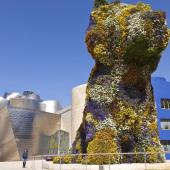Exhibition Jan Fabre
The ongoing exhibition of the famous Belgian artist Jan Fabre in the Hermitage, one of the biggest and most important art and cultural history museums in Russia, caused horror. There are many bad reviews in the social networks in the Russian segment of the Internet. People demand the immediate closure of the exposition and the banishment of the exhibits from the museum.
The exhibition shows stupid animals hanging from a ceiling or nailed onto the wall. Some critics consider this an act of cruelty. From their point of view, it is about fagging, trying to hide something else behind it. In addition, the exhibition drew the attention of the church. The head of the St. Petersburg diocese for relationship between church and society, Archpriest Alexander Pelin, said, "It all looks quite scandalous." According to him, the staff of the Hermitage are unhappy with the exhibition and they´d consider the exposition inappropriate. The exhibition "Jan Fabre: Knights of Despair - Warriors of Beauty", which makes so much noise, already opened in mid-October and will last until 9th April 2017. The exhibition is only recommended at the age of 16.
The exhibition will show over 200 artworks by the Belgian champion. Some were specifically selected for the Hermitage. According to the institution, the expert uses "the aesthetics of the animal world". In his exhibition, there are beetles, shells, skeletons, horns and stuffed animals in various forms.
The origins of Jan Fabre's creativity go back to the tradition of classical Flemish painting. He draws inspiration from the works of Peter Paul Rubens and Jacob Jordaens. The fact that his exhibition has raised a lot of discussion is the best proof of his place in the art scene. It is the duty of art to stir up society, isn´t it?
Fabre's exhibition is one of his attempts to talk about the eternal topics that have always bothered and disturbed humanity. There are the issues of life and death and the many injustices that our world offers. The exhibition of the artist draws attention to the suffering of our brethren, of whom many died because of mistakes of others or because of indifference.
The artist addresses hisself to animal cruelty. Anyone who visits his exhibition has the right to ask oneself: "If a pet, who has satisfied and accompanied me for many years, becomes old and sick, and is no longer as beautiful as before – do I want to take care of it until the last minute, or will I free myself from it?"




